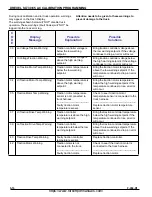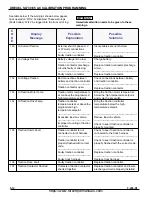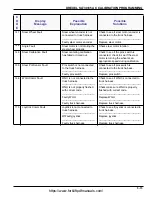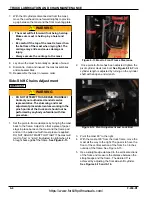
6-6
F-459-R1
TRUCK LUBRICATION AND CHAIN MAINTENANCE
2.
Check to see that an unloaded mast will completely
lift to full lift height (the relief valve opens). If it will
not, check the hydraulic oil level in the reservoir and
add oil if necessary.
3.
Load the mast and raise it approximately to 5’ (1.524
m), then quickly lower the mast until it is about 6”
(1.524 mm) above the floor and stop the mast
abruptly.
4.
Make sure the elevating channel rollers maintain
proper contact with the mast channel.
5.
Look for signs of galling where the rollers contact the
rail. Galling is indicated by track marks in the rails
that are 1/4” to 1/2” (6.35 mm to 12.7 mm) wide
running up the rail. Normal track marks are no more
than 1/4” (6.35 mm) wide.
6.
If galling is detected, adjust the rollers for the proper
clearance over the full length of the mast rails. See
“Inspection Check List” beginning on page 1-7
Checking and Adjusting Degree of Tilt
1. To check degree of tilt, be certain the truck is on a
smooth, level surface.
2. Tilt the mast completely back. Place the tilt gauge
against the rear outer mast rail on the right side of
the truck.
3.
Available tilt is limited to 3° forward and 4° back.
4. To adjust the degree of tilt, tilt the mast fully
backward.
5.
Set the key switch to OFF and remove the key from
the key switch.
WARNING
6.
Loosen the tilt cylinder adjuster bolt.
7.
Continue to loosen the tilt cylinder adjuster bolt until
there is no bolt pressure on the tilt cylinder clevis.
8.
Place the tilt gauge against the rear outer mast rail
on the right side of the truck, about 6” (152 mm)
above the mast cross member. See Figure 6-11.
CAUTION
9.
Relieve the hydraulic pressure on the tilt cylinder.
Rotate the tilt cylinder rod using a 1-3/4 open end
wrench on the tilt cylinder rod. Looking at the rod end
of the cylinder turn clockwise to shorten the rear tilt
or counterclockwise to increase the rear tilt. It is best
to turn the rod only a 1/2 turn at a time. See
Figure 6-12.
10. You may have to tilt the mast a number of times,
repeating steps 4 thru 9, until the adjustment is
correct.
NOTE
At this time, make sure all hydraulic hoses, electrical
wiring and all parts of the mast move smoothly and clear
the frame when the mast is going through the complete
tilt movement. Also check and correct mast flex, a
misadjustment of the tilt cylinders that causes one tilt
cylinder to bottom out before the other one has
completed travel.
11. When the adjustment is complete, reinsert the key
and turn to the ON position. Using the tilt cylinder
lever, tilt the mast back to its full stroke.
12. Tighten and torque the tilt cylinder adjuster bolt
against the cylinder clevis. See General Torque,
Hydraulic Fitting Torque, and SLT30/35 AC Torque
Tables on page 1-12.
Figure 6-11 Mast Tilt Gauge
Do not service the tilt cylinder while the key
switch is ON. If a joystick, steering wheel or
accelerator pedal is accidentally moved, you
could be caught between the mast and the truck,
causing serious injury.
NEVER exceed 4.0° rear tilt for masts. Rear tilt in
excess of recommended values can cause
instability.
https://www.forkliftpdfmanuals.com/






















